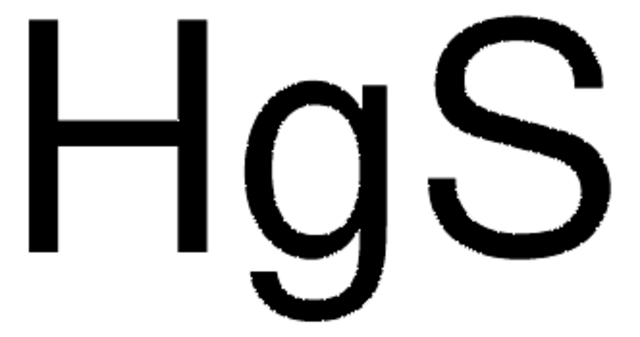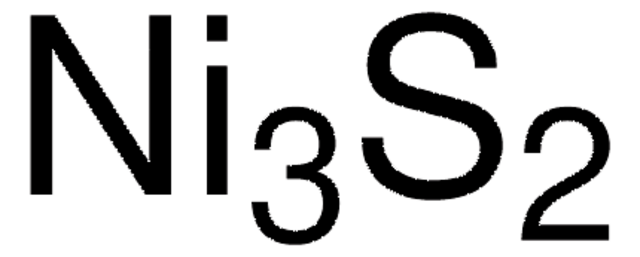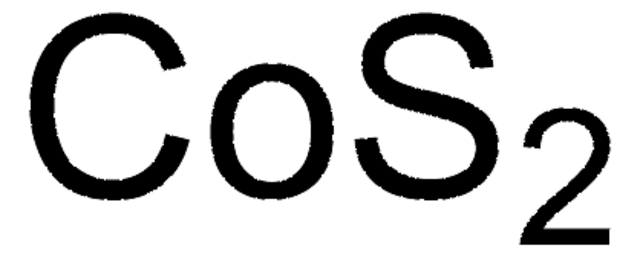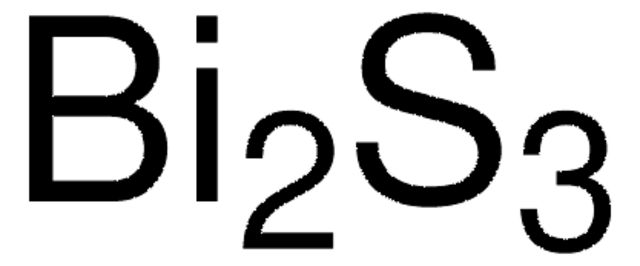Alle Fotos(3)
Wichtige Dokumente
342467
Kupfer(II)-sulfid
powder, −100 mesh, ≥99% trace metals basis
Synonym(e):
Copper Blue, Copper monosulfide, Cupric sulfide, Horace Vernet′s Blue
Anmeldenzur Ansicht organisationsspezifischer und vertraglich vereinbarter Preise
Alle Fotos(3)
About This Item
Empirische Formel (Hill-System):
CuS
CAS-Nummer:
Molekulargewicht:
95.61
EG-Nummer:
MDL-Nummer:
UNSPSC-Code:
12352300
PubChem Substanz-ID:
NACRES:
NA.23
Empfohlene Produkte
Qualitätsniveau
Assay
≥99% trace metals basis
Form
powder
Partikelgröße
−100 mesh
mp (Schmelzpunkt)
220 °C (dec.) (lit.)
Dichte
4.6 g/mL at 25 °C (lit.)
Anwendung(en)
battery manufacturing
SMILES String
S=[Cu]
InChI
1S/Cu.S
InChIKey
BWFPGXWASODCHM-UHFFFAOYSA-N
Suchen Sie nach ähnlichen Produkten? Aufrufen Leitfaden zum Produktvergleich
Verwandte Kategorien
Allgemeine Beschreibung
Cu63 NMR, X ray photoelectron spectroscopy,2 copper sulfide CuS was studied in detail.
Verpackung
Packaged in glass bottles
Lagerklassenschlüssel
11 - Combustible Solids
WGK
WGK 3
Flammpunkt (°F)
Not applicable
Flammpunkt (°C)
Not applicable
Persönliche Schutzausrüstung
Eyeshields, Gloves, type N95 (US)
Hier finden Sie alle aktuellen Versionen:
Besitzen Sie dieses Produkt bereits?
In der Dokumentenbibliothek finden Sie die Dokumentation zu den Produkten, die Sie kürzlich erworben haben.
K Pedersen
Journal of applied microbiology, 108(3), 1094-1104 (2009-12-18)
To investigate the relationships between sulfate-reducing bacteria (SRB), growth conditions, bentonite densities and copper sulfide generation under circumstances relevant to underground, high-level radioactive waste repositories. Experiments took place 450 m underground, connected under in situ pressure to groundwater containing SRB.
Qiwei Tian et al.
ACS nano, 5(12), 9761-9771 (2011-11-09)
Photothermal ablation (PTA) therapy has a great potential to revolutionize conventional therapeutic approaches for cancers, but it has been limited by difficulties in obtaining biocompatible photothermal agents that have low cost, small size (<100 nm), and high photothermal conversion efficiency.
Geng Ku et al.
ACS nano, 6(8), 7489-7496 (2012-07-21)
Photoacoustic tomography (PAT) is an emerging molecular imaging modality. Here, we demonstrate use of semiconductor copper sulfide nanoparticles (CuS NPs) for PAT with an Nd:YAG laser at a wavelength of 1064 nm. CuS NPs allowed visualization of mouse brain after
Wei Zhu et al.
Bioresource technology, 102(4), 3877-3882 (2011-01-05)
The sulfur oxidation activities of four pure thermophilic archaea Acidianus brierleyi (JCM 8954), Metallosphaera sedula (YN 23), Acidianus manzaensis (YN 25) and Sulfolobus metallicus (YN 24) and their mixture in bioleaching chalcopyrite were compared. Meanwhile, the relevant surface sulfur speciation
Caifeng Ding et al.
Biosensors & bioelectronics, 25(5), 1082-1087 (2009-10-27)
An ultrasensitive chemiluminescence method based on the Au nanoparticles amplification for the quantitative detection of single-nucleotide polymorphisms (SNPs) in genomic DNA was accomplished by the DNA polymerase I (Klenow fragment)-induced coupling of the nucleotide-modified nanoparticle probe to the mutant sites
Global Trade Item Number
| SKU | GTIN |
|---|---|
| 342467-100G | 4061826757383 |
| 342467-500G | 4061826757390 |
Unser Team von Wissenschaftlern verfügt über Erfahrung in allen Forschungsbereichen einschließlich Life Science, Materialwissenschaften, chemischer Synthese, Chromatographie, Analytik und vielen mehr..
Setzen Sie sich mit dem technischen Dienst in Verbindung.







